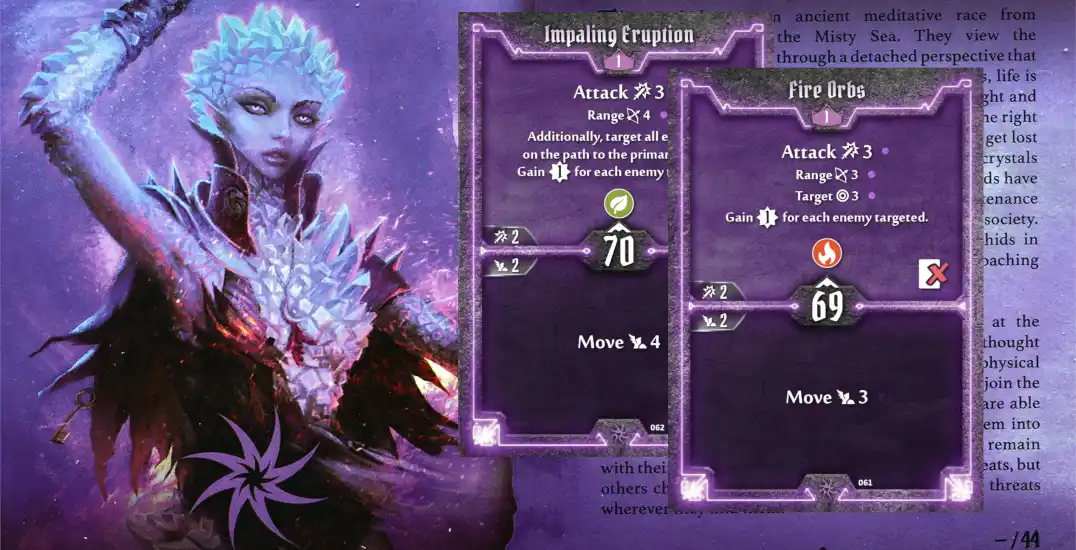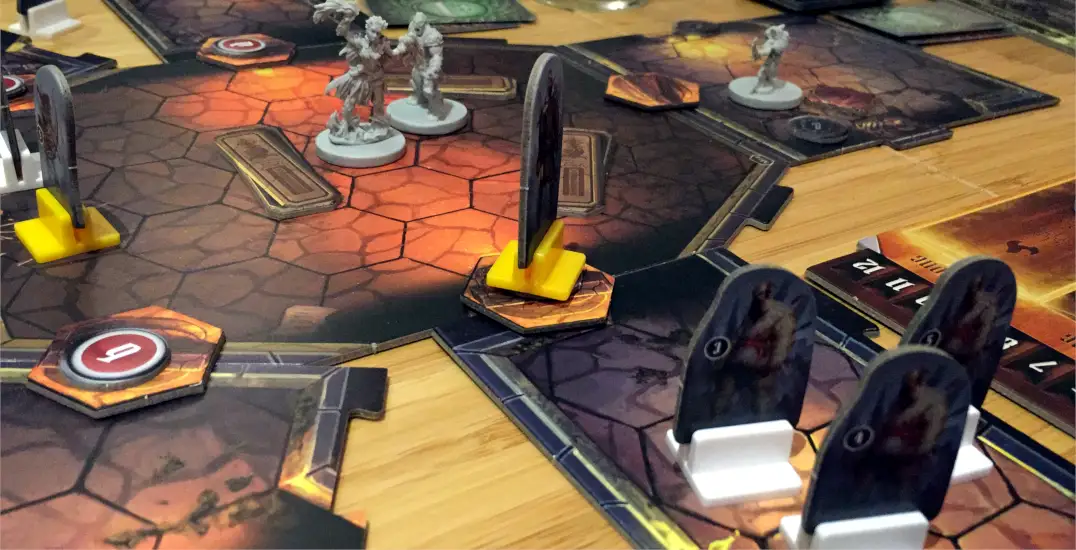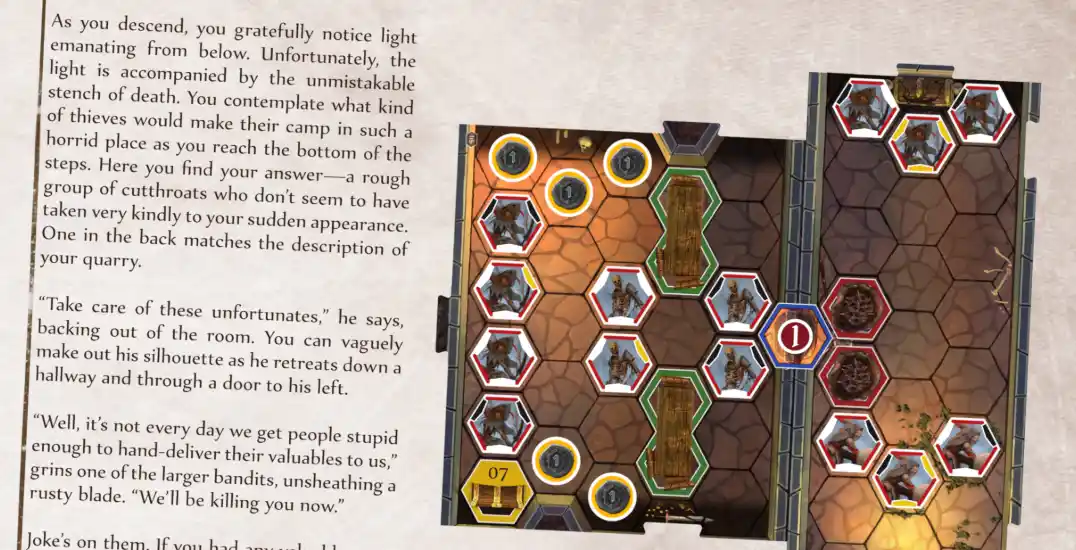
I’ve always wanted a dungeon crawler with depth. While the appeal of fighting monsters in a trap-filled maze is undeniable, the genre has rarely required much in the way of strategy. Moving towards the bad guys and rolling dice to hit them has remained the backbone of the genre and Gloomhaven, its current champion, does little to break away from this trend.
DUNGEON CRAWL
Gloomhaven is, in many ways, a standard dungeon crawler. Every player selects a hero, we are given an excuse to band together and then we proceed to hack and slash our way to victory. The core of the game is moving around a modular board and then attacking enemies until they drop dead. It’s not far off from Heroquest, though it does feature several improvements.
In order to move, attack or perform any other action we use cards. Each is divided in two halves, with the upper one mostly representing attacks and the bottom mostly representing utility or movement. We play two per turn, the only restriction being that we must choose two different halves. Hence, most of the time we’ll attack and move, in whatever order is most handy.
Attacks come with a set amount of damage in them, which is then modified with a dice roll. However, no dice come with it. Rather, players (and monsters) use their own 20-card decks to replace them. This allows for a couple small tricks, like adding more misses or critical hits or slightly improving our numbers as we level up.
What separates Gloomhaven from the other sons of Heroquest is its sheer size. Its box takes the space of at least five other games. It has more cards of one type than most games have in total and more damage chits than they have cardboard. It’s not a mere game, it’s a whole product line including all features one may have in a dungeon crawl. As far as “content” goes, it’s a triumph.
 Characters can be upgraded, cards modified, dice changed and a decorative map can be illustrated with additional stickers. There’s treasure to gain, donations to make and a morality track that tells you if you are good or bad. And, of course, there’s miniatures and standees and rooms and more characters than one could feasibly play. Gloomhaven wants the full experience of a roleplaying game.
Characters can be upgraded, cards modified, dice changed and a decorative map can be illustrated with additional stickers. There’s treasure to gain, donations to make and a morality track that tells you if you are good or bad. And, of course, there’s miniatures and standees and rooms and more characters than one could feasibly play. Gloomhaven wants the full experience of a roleplaying game.
Hence, the default mode of play is a book with 95 scenarios tied together in a campaign. We are meant to play it with the same group and meet pretty much every week to do so. It’s a huge investment as far as time is concerned, and I ended up putting more effort into it than most games I’ve ever played. Sadly, it was all for naught. Gloomhaven failed to deliver the quality experience I expected from it, or from any other game.
DECISION-MAKING
In my 20 to 30 plays of Gloomhaven, I never had to make a meaningful decision. Every time, as the scenario started and we faced a horde of enemies, I did the same thing. I used the multi-target fireballs and boosted them with a pair of mystical glasses. This gave me a critical hit, ensuring maximum damage to a wide array of targets. Then it was a matter of picking up the leftovers.
It’s not that I’m a strategic genius. Rather, the design of the game makes these plays obvious. If our options are limited to a bunch of normal attacks, a few utility options like extra movement and a fireball that hits up to three targets, it doesn’t take much to realize when to use the latter. The specifics change between characters but they all fell to the same rote play patterns.
After all, since we always start with the same hand, we can always fall into the same tried and true strategies. There’s no incentive to change – playing worse isn’t more fun – and with less than a dozen cards in our hand, finding the right play is easy. The dungeon may be different each time, but they are all traversed the same. Level design is conspicuously absent beyond awkwardly-placed rocks that force us to take more turns to reach the end.
 More importantly, enemies do not force us to play differently. Most opposing creatures are stat blocks with no distinctive features. It may take more effort to slay a giant than a rat but both succumb to the same sword. The handful that do have abilities are rarely impactful. After all, faeries can’t screw up your attacks if they are all dead to a fireball.
More importantly, enemies do not force us to play differently. Most opposing creatures are stat blocks with no distinctive features. It may take more effort to slay a giant than a rat but both succumb to the same sword. The handful that do have abilities are rarely impactful. After all, faeries can’t screw up your attacks if they are all dead to a fireball.
Ultimately, Gloomhaven is an efficiency puzzle. Only three things matter: Damage, life points and how many hexes we need to cross through to reach the last room. In that sense, it’s not that far from Stone Age, Terra Mystica or any Stefan Feld game. I’m not a huge fan of these games – I don’t find efficiency an interesting goal of its own – but Gloomhaven is not as good as them and much, much slower.
SLOW
Most of the time playing in Gloomhaven is spent keeping the game working. Damage must be painstakingly tracked chit by chit, as are the myriad of status effects. Attacking Goblin #13 will have us roll the die, search for the tokens, put them in the right corner of the damage tracker and so on for the dozen monsters on the board. This is a very slow process.
Enemies are handled the same way. First we reveal a card from their unique enemy deck. Then, if they move, they approach the closest player. Then, if they attack, we draw dice cards for them and calculate damage. Sometimes the enemy deck has unique effects. Most of the time, however, it’s a matter of how much and how hard.
It’s a bit like playing Dragon Quest without a video game console. You can print the monster data and then calculate the damage and run the code yourself. It works, but it’s not an experience suited to the tabletop. If Gloomhaven were a computer game (which it now is), a scenario would not take more than 15 minutes. But since we must manage everything manually, we are looking at 60 to 90 minutes per map.
 There’s an app called Gloomhaven Helper which helps palliate this issue. But even with a computer keeping track, the ratio of meaningful decisions compared to upkeep is too low. It’s not just about the time it takes to complete a scenario. Gloomhaven is simply not worth the effort of meeting every other week to complete it.
There’s an app called Gloomhaven Helper which helps palliate this issue. But even with a computer keeping track, the ratio of meaningful decisions compared to upkeep is too low. It’s not just about the time it takes to complete a scenario. Gloomhaven is simply not worth the effort of meeting every other week to complete it.
ROLEPLAYING ALTERNATIVES
Gloomhaven seeks to capture the “roleplaying experience”. It bills itself, not just a puzzle, but an adventure with an ongoing story and character development. It follows Arkham Horror and Shadows of Brimstone in trying to be a little like Call of Cthulhu or Dungeons and Dragons. And yet, it never comes close to capturing the quality of storytelling those games are capable of.
Before and after each scenario, Gloomhaven gives us a bit of text. This is meant to give some context to our actions, yet it doesn’t do much. It rarely has an impact on the fighting. Most of the time, we are simply given an excuse to kill or find a McGuffin. The only memorable moments were a pie eating contest and a surprisingly edgy bit in which the main characters massacre innocent rat-people.
Some time after playing Gloomhaven I got embroiled in a D&D campaign. We spent four days playing The Lost Mines of Phandelver, the current starter scenario for the system. It was slow and repetitive and I would rank it in the bottom half of my roleplaying experiences. And yet, I had more fun in those four days than I had during all my plays of Gloomhaven.
It wasn’t difficult, either. There’s this idea that roleplaying is so complicated that we need “rpg-lites” to provide a first experience. But that’s not true. Anyone who plays board games can jump into Dungeons & Dragons. And, if what we truly seek is a tactical experience, there’s a whole genre of wargames that excels at it.
 Ultimately, I never felt Gloomhaven was the right game for my time. As an efficiency puzzle, it’s less interesting than the average eurogame. As a fantasy adventure, it pales against roleplaying. Even as a solo game, I would rather check out Fire Emblem or Vestaria Saga on my PC. It never gave me the joy of other titles and did not deserve the amount of play I put into it.
Ultimately, I never felt Gloomhaven was the right game for my time. As an efficiency puzzle, it’s less interesting than the average eurogame. As a fantasy adventure, it pales against roleplaying. Even as a solo game, I would rather check out Fire Emblem or Vestaria Saga on my PC. It never gave me the joy of other titles and did not deserve the amount of play I put into it.
| GLOOMHAVEN (2017) | |||
|---|---|---|---|
| DESIGN | Isaac Childres | ART | Alexandr Elichev Josh T. McDowell Alvaro Nebot |
| PUBLISHER | Cephalofair Games Asmodee | LENGTH | 60-90 Minutes per scenario |
| NUMBER OF PLAYERS | 1-4 (Best with any number) | SCORE | ★ |




Nice write-up. I don’t agree with all your points but I see where you’re coming from, mostly. I’ve had a lot of fun playing Gloomhaven but the set up and take down and sheer book-keeping is just mind boggling and on another level. Even with the helpers and organisers to make getting components easier than ever (thank you Plano!) the game is so unwieldy that it’s been collecting dust on my shelf for several years now.
Thank you Jack! The setup is a problem, I was lucky enough to play with someone who owned an organized specifically made for the game. More importantly, he set it up before we got there. I can’t imagine taking it away to play. Still, if you like the game I really recommend giving the app a try. Just not having to take out as much cardboard helps a lot.
We have Gloomhaven Jaws of the Lion, it’s smaller, cheaper cousin, with 20ish scenarios and the maps in a book format (quicker to set up that the tiles). The rules (AFAIK) are the same.
We found that the game was so tight that a bad ‘dice roll’ when attacking could make that scenario impossible to the point where it became a luck game with the buy-in being the time to set everything up.
We’ve tried various fixes to this, the best I can find is removing the critical miss cards from the combat deck. But even so it’s very tight on the number of actions you get.
Of course this may be down to poor character synergy (we’re playing 2 player with 2 of the 4 characters) or bad levelling decisions (although we’re not new to dungeon crawlers), either way it hasn’t made is back to the table recently due to the dread felt that setting it up could be a waste of time due to a loss beyond our control.
I’m sorry to hear you are having a bad time. While I haevn’t played Jaws of the Lion, I did notice the scaling in the original was a bit wonky. Being one level up or down could have a large impact on the difficulty. You still have the same number of cards in your hand no matter the player count, too, so even if there are less enemies, the proportion is not the same. Either way, I recommend buying the Stamina potion if you haven’t, it’s very cheap, quite strong and buys you an extra turn. That and the glasses go a far way.
Still, it’s a shame. And the setup is a problem. When I played the game the host set it up in advance but even just putting it back into the box was a problem.
I’ve always wondered why people reach for RPGish board games when you can just reach for an RPG. The genre exploded onto the the scene in the 70s for a reason.
I think there are several reasons, but a big one is that people just don’t know about them. I think most board games are aware of RPGs, but have never played one.
The GM prep probably takes longer than the board setup, and there’s the whole “nobody wants to GM” problem.